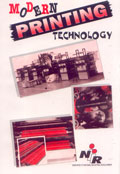Printing is one of those inventions that have revolutionized our world and is the most important fundamental practices in our society. Nothing is more essential to civilization intellectually or commercially, than printing. Printing is widely used in our society to pass on information and to decorate objects. Printing is a process for reproducing text and images, typically with ink on paper using a printing press. It is often carried out as a large scale industrial process, and is an essential part of publishing and transaction printing. There are various types of printing methods such as screen printing, offset printing, rotogravure printing etc. Offset printing is a widely used printing technique where the inked image is transferred (or offset) from a plate to a rubber blanket, then to the printing surface. There is an enormous growth being witnessed in the printing industry. The emergence of the retail revolution and growing education across the country is acting as a fuel to the growth of the printing industry. The Indian Printing Industry is well established and presently growing at 12% per annum.
This book provides you details about the various methods and techniques involves in modern printing technology. Some of the fundamentals of the book are multi colours, paper publishing unit, screen printing, offset printing press, rotogravure printing, desk top publishing, computer forms and security printing press, printing inks, ink for hot stamping foil, aluminium printing plate for offset printing machine, screen printing on cotton, polyester and acrylics. The book also covers process, project profiles of different types of printings and printing inks manufacturing along with sources of machinery and raw materials.
The book provides you with comprehensive information on modern printing technology. Basic information in entering a market and the opportunities and requirements of the potential sector has been the best way to penetrate in a market. How and what if properly answered can take you to a long way. The first hand information on different types of modern printing technology has been properly dealt in the book and can be very resourceful for those looking for entrepreneurship opportunity in this sector.

Modern Printing Technology
Format: paperback
Code: NI4
Pages: 152
ISBN: 8186623221
Publisher: National Institute of Industrial Research
$0
₹0
1. Multi Colours 8 Page Paper Publishing Unit
2. Screen Printing
3. Offset Printing Press
4. Rotogravure Printing
5. Desk Top Publishing
6. Computer Forms And Security Printing Press
7. Printing Inks
8. Ink For Hot Stamping Foil
9. Aluminium Printing Plate For Off-Set Printing Machine
10. Screen Printing On Cotton, Polyester And Acrylics
Customer Reviews
No reviews yet. Be the first to write one!

